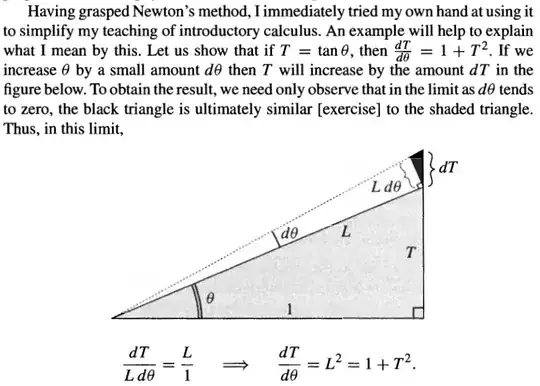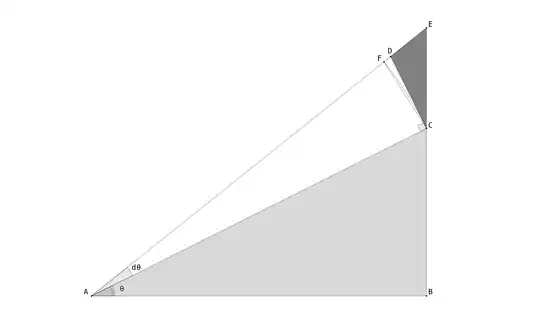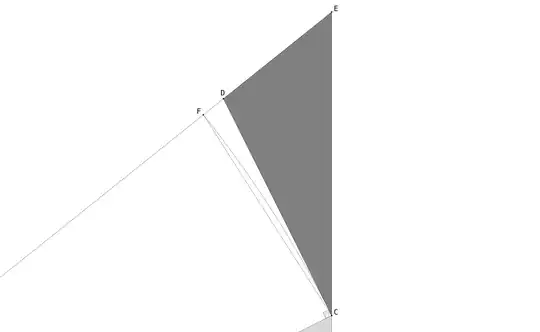I was reading Needham's Visual Complex Analysis, and could not figure out how we get length $Ld\theta$ here:
2 Answers
It is just an approximation of the arc length of that sector with radius $L$ and angle $dθ$. Note that such a method as presented in that text is totally not rigorous, and will not help you learn to rigorously prove anything in complex analysis!
- 57,693
- 9
- 98
- 256
-
Thank you so much for clarifying that. :) – Silent Aug 08 '15 at 09:34
-
I have written a competing answer below. Just pinging since I felt you might be interested in glancing through it. – Jan 15 '21 at 22:48
-
A little bit more rigorous would be that the area of the triangle with sides $(\sec\theta, \tan(\theta + d\theta) - \tan \theta , \sec(\theta+d\theta)) = \frac 12 (\tan(\theta + d\theta) - \tan \theta)$ And, this is greater than the area of the section of the circle of radius $\sec\theta$ and less than the section of the cricle with radius $\sec(\theta + d\theta)$ Establishing the inequality $\sec^2\theta \ d\theta \le \tan(\theta + d\theta) \le \sec^2 (\theta + d\theta)\ d\theta.$ We can the use the squeze theorem to find $\frac {d}{d\theta}\tan\theta$ – Doug M Jan 15 '21 at 22:56
-
@anonymous_user: Thanks for the ping, see my comment on your answer for why it's wrong. – user21820 Jan 16 '21 at 07:41
-
@DougM: As you and I both know, there are many ways to rigorously obtain the desired theorem. But handwaving in the form quoted in the question is not one of them. By the way, if you want proper mathematical rigour, you should not invoke area unless you have rigorously defined area and proven the theorems required to justify your "a little bit more rigorous" argument. I guess you probably knew that too. – user21820 Jan 16 '21 at 07:44
By "ultimately similar" Needham means the following (see pages 20–21):
We stress here the words "ultimately equal" and "infinitesimal" are being used in delicate, technical senses; in particular, "infinitesimal" does not refer to some mystical, infinitely small quantity7. More precisely, if two quantities $X$ and $Y$ depend on a third quantity $\delta$, then \begin{align*} \lim_{\delta \to 0} \frac{X}{Y}\quad & \iff \quad \text{"$X = Y$ for infinitesimal $\delta$".}\\ &\iff \quad \text{"$X$ and $Y$ are ultimately equal as $\delta$ tends to zero".} \end{align*} It follows from the basic theorems on limits that "ultimate equality" inherits many of the properties of ordinary equality.
7For more on this distinction, see the discussion in Chandrasekhar [1995].
Since two triangles are similar if and only if they have the same set of (internal) angles when Needham says that "the black triangle is ultimately similar [exercise] to the shaded triangle" he probably means that the ratio of any angle of the black triangle with the corresponding angle of the shaded triangle tends to $1$ as $d\theta$ tends to zero.
Let the shaded triangle be labelled $\triangle \mathit{ABC}$, where $\angle A = \theta$ and $\angle B = \pi/2$. The black triangle $\triangle\mathit{CDE}$ is obtained by constructing the perpendicular to the line segment $\mathit{AC}$ at $C$ and taking the point $D$ to be where it meets the straight line that is at an angle of $\theta + d\theta$ to the base $\mathit{AB}$, and by extending the segment $\mathit{BC}$ until it meets the same line at the point $E$.
Let us compute the angles of $\triangle \mathit{CDE}$. Examining $\triangle \mathit{ABE}$, we have $\angle E = \pi/2 - \theta - d\theta$ in $\triangle \mathit{CDE}$. Examining $\triangle \mathit{ACD}$, we have $\angle D$ in this triangle to be $\pi/2 - d\theta$. Hence, $\angle D$ in $\triangle \mathit{CDE}$ equals $\pi/2 + d\theta$. Thus, we must have $\angle C$ in $\triangle \mathit{CDE}$ to be equal to $\theta$ (this could also have been seen directly from our construction of $\triangle \mathit{CDE}$).
So, what do the ratios of corresponding angles between $\triangle \mathit{ABC}$ and $\triangle{\mathit{CDE}}$ look like in the limit as $d\theta \to 0$? \begin{align*} &\lim_{d\theta \to 0} \frac{\angle \mathit{CAB}}{\angle \mathit{DCE}} = \lim_{d\theta \to 0} \frac{\theta}{\theta} = 1.\\ &\lim_{d\theta \to 0} \frac{\angle \mathit{BCA}}{\angle \mathit{CED}} = \lim_{d\theta \to 0} \frac{\pi/2 - \theta}{\pi/2 - \theta - d\theta} = 1.\\ &\lim_{d\theta \to 0} \frac{\angle \mathit{ABC}}{\angle \mathit{EDC}} = \lim_{d\theta \to 0} \frac{\pi/2}{\pi/2 + d\theta} = 1.\\ \end{align*}
This proves that the black triangle and shaded triangle in Needham's diagram are ultimately similar. (Of course, we could have just done this for any two angles, since the third angle of a triangle is uniquely determined once the other two are specified.)
Now, call $\lvert \mathit{CE} \rvert$ to be $dT$. What can we say about $\lvert \mathit{CD} \rvert$? Let $F$ be the point on the segment $\mathit{AD}$ such that $\lvert \mathit{AF} \rvert = \lvert \mathit{AC} \rvert = L$. Then, certainly $\lvert \mathit{CF} \rvert < L\, d\theta < \lvert \mathit{CD} \rvert$. So, to show that $L\, d\theta$ and $\lvert \mathit{CD} \rvert$ are ultimately equal, it suffices to show that $\lvert \mathit{CF} \rvert$ and $\lvert \mathit{CD} \rvert$ are ultimately equal.
Applying the cosine law on $\triangle \mathit{ACF}$, we get $$ \cos(d\theta) = \frac{L^2 + L^2 - \lvert \mathit{CF} \rvert^2}{2^{\vphantom{2}}\!\;\! L^2} \implies \lvert \mathit{CF} \rvert = 2L\sin\left(\frac{d\theta}{2}\right). $$ Examining $\triangle \mathit{ACD}$, we have $$\tan(d\theta) = \frac{\lvert \mathit{CD} \rvert }{ L } \implies \lvert \mathit{CD} \rvert = \frac{2L\tan \left(\frac{d\theta}{2}\right)}{1^\vphantom{2}\! - \tan^2 \left(\frac{d\theta}{2}\right)}. $$ Thus, $$ \frac{\lvert \mathit{CF} \rvert}{\lvert \mathit{CD} \rvert} = \cos\left(\frac{d\theta}{2}\right) \cdot \left(1 - \tan^2\left(\frac{d\theta}{2}\right)\right). $$ As $d\theta$ tends to $0$ the RHS tends to $1$, so $\lvert \mathit{CF} \rvert$ and $\lvert \mathit{CD} \rvert$ are ultimately equal.
To summarise, the ratio $\dfrac{\lvert \mathit{CE} \rvert}{\lvert \mathit{CD} \rvert}$ is ultimately equal to $\dfrac{\lvert \mathit{AC} \rvert}{\lvert \mathit{AB} \rvert}$ because $\triangle \mathit{CDE}$ is ultimately similar to $\triangle \mathit{ABC}$, and $\lvert \mathit{CD} \rvert$ is ultimately equal to $L\, d\theta$. Thus, $\dfrac{dT}{L\, d\theta}$ is ultimately equal to $\dfrac{L}{1}$, so we get $$ \frac{dT}{d\theta} = L^2 = 1 + T^2 $$ in the limit as $d\theta \to 0$.
The reference to Chandrasekhar [1995] mentioned in footnote 7 in the quote at the beginning is listed on page 574 as follows: S. Chandrasekhar (1995), Newton's Principia for the Common Reader. Clarendon Press, Oxford.
-
I think you meant to have "$\cdots{}=1$" in your first limit expression. However, your argument is wrong, and illustrates why one should do proper real analysis rather than using imprecise handwaving about "ultimately equal". At one point you effectively claim that if $a<b·d<a+c$ and $c → 0$ as $d → 0$, then $b·d/a → 1$ as $d → 0$. This is false! You did not control the rate at which $a → 0$ as $d → 0$. I did not continue checking past that error. – user21820 Jan 16 '21 at 07:40
-
@user21820 Ah, quite right... Thank you for going through it and giving feedback. Indeed, there is no point in checking past that error. – Jan 16 '21 at 09:53
-
-
I'm sorry I missed an earlier gap in your argument. You claimed that $L·dθ < |CD|$, but this is very difficult to justify rigorously. In fact, the other inequality $|CF| < L·dθ$ is also not justified but at least can reasonably be hand-waved (though a rigorous justification would still have to define arc length of a smooth curve). I hope you realize now that it is highly non-trivial to rigorously prove the desired result along this kind of line of reasoning. In case you are interested, see this post and the post that it links to. – user21820 Jan 16 '21 at 15:15
-
@user21820 Thank you once again for taking the time to go through my answer and giving feedback. If I'm not mistaken, the claim that $L, d\theta < \lvert \mathit{CD} \rvert$ is implied by (or equivalent to?) $x < \tan(x)$ for $0 < x < \pi/2$, and $\lvert \mathit{CF} \rvert < L, d\theta$ is saying that the length of a chord in a circle is less than the length of the arc subtended by that chord. – Jan 16 '21 at 21:00
-
@user21820 I find it fascinating that these claims are not really that easy to justify unless the notions of angle, length, area, etc. are developed rigorously. Thank you for the link, I will carefully go through it and the other answers of yours linked to that post. – Jan 16 '21 at 21:01
-
You are not wrong, but did you realize that $x < \tan(x)$ is non-trivial to justify no matter what definition of $\tan$ you use? Ironically, the goal of the question here was to find the derivative of (real-valued) $\tan$, which is no easier than finding the derivative of $\sin$, which is often done sloppily in various texts by appealing to $x < \tan(x)$... Although I would agree with anyone who says that defining the trigonometric functions via their series is somewhat unnatural, I still think it's the best way to fully rigourous definitions that work on $ℂ$ as well. You're welcome! =) – user21820 Jan 17 '21 at 03:09
-
By the way, in my preferred approach, the fastest way to prove that $x ≤ \tan(x)$ for $x ≥ 0$ is to compare derivatives $1 ≤ 1/\cos(x)^2$. This requires Rolle's theorem and prior proof of derivatives of $\sin,\cos$. Of course, we can't do this at all if we are trying to prove the derivative of geometrically-defined $\sin$. That is why the better textbooks that attempt this use area instead of arc-length. Still, it's non-trivial to get area right. Either one has to define area via integration, or at least define Jordan area. – user21820 Jan 17 '21 at 03:21
-
@user21820 Another fascinating link, thank you very much for sharing! I have been a bit wary of the proof of $x < \tan x$ for $0 < x < \pi/2$ that uses comparison of areas. It is intuitively appealing, but it seems to me that the more fundamental question of what one really means by area is brushed under the carpet. I am sure I will enjoy reading and re-reading your writings on these matters. :) – Jan 17 '21 at 07:37
-
Actually, area is easier to work with than arc length, as far as I can tell. By the way, feel free to ping me in this chat-room for future discussion about real analysis, whether related to this or not! =) – user21820 Jan 17 '21 at 09:24


